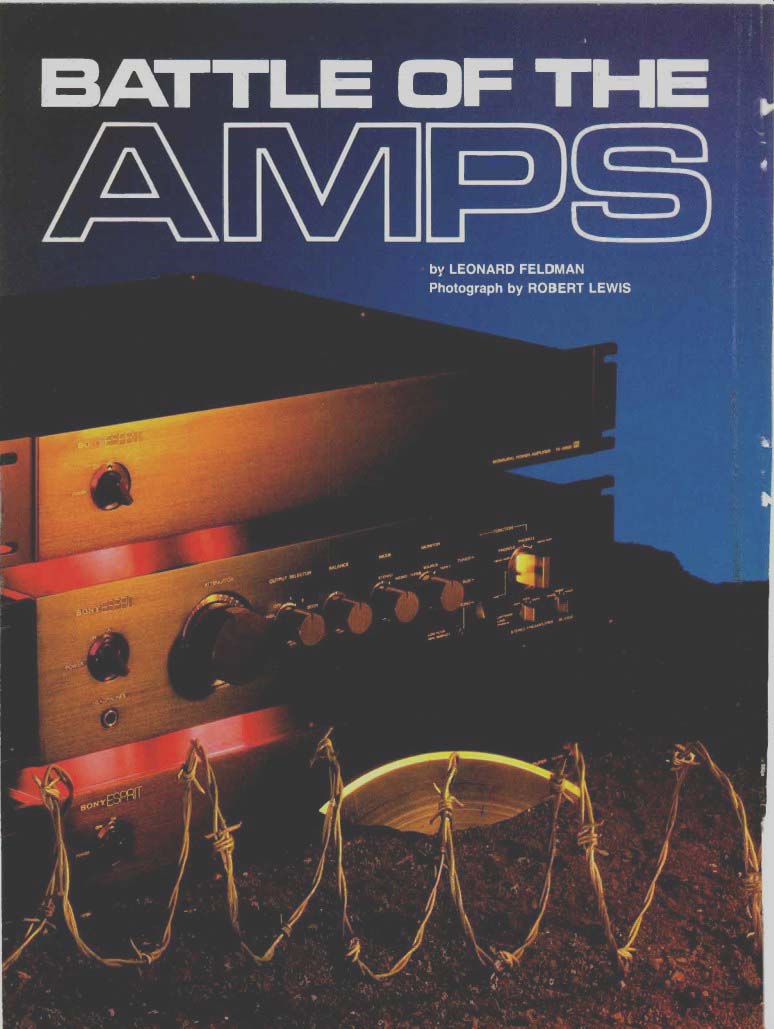

by LEONARD FELDMAN
Photograph by ROBERT LEWIS
High-end audio holds a very special place in Japan and constitutes a larger percentage o' the market than it does in this country. While some U.S.-made gear is very hot there, Japanese manufacturers often consider this area to be one where their prestige is at stake. A fair amount of this Japanese-produced high-end gear never makes it to the States; when it does, many of these "all out" products reach substantially fewer dealers. It is also a3parent that different design approaches are used in these state-of-the-art attempts, for different and much less cost-effective features are often found in them.
Indeed, such products are some times highly impractical for mass production since they embody de sign philosophies radically different from those found in mid-level gear.
This is not merely because of combining sophisticated designs with relatively small sales. Why put 150 pounds of sand-casting and 20 coats of hand-rubbed lacquer into a turntable with a production run of 100? The answer I've always received is, "That's what we thought was needed to make it correctly." Whatever your feelings about this approach to hi-fi manufacture, roe think it deserves this closer look.
-E.P.

------- Denon PRA-6000 preamplifier and POA 8000 power amps
Most large Japanese manufacturers of audio equipment have a few high-end, high-performance products which have been designed without regard to price or number of units that are expected to be sold. Call them "image builders," "showpieces" or what ever you like, these no-holds-barred products represent the closest thing to true state-of-the-art and perfection that the top engineers of these companies are able to create. Analogies with other categories of equipment (such as mo tor cars or sailboats) generally aren't applicable when it comes to these top-of-the-line audio products, although one statement often attributed to yacht and Rolls Royce salesmen does apply here, "If you have to ask how much it costs, you can't afford it!" The Editor of Audio and I decided that it might be interesting (and a great deal of fun, besides) to pit one such top system against another; not so much for the purpose of coming up with a clear sonic "winner," but rather to present the points of view of two top design teams and to explore the differences in philosophy inherent in the de signs of two obviously superior audio electronics systems. We chose for these comparisons Denon's top stereo preamplifier, Model PRA-6000, operating with a pair of Denon POA-8000 monaural power amplifiers as one of the systems. The other system consisted of a Sony TA-E900 stereo preamplifier and a pair of Sony TA-N900 monaural power amplifiers, all three of which are part of Sony's "Esprit" line of audio components.
Denon Preamplifier Layout
The PRA-6000 preamplifier/control unit's dark front panel is elegantly off set by a pair of gold-colored metal end blocks, tapered to form a pleasing frame for the unit. Only the most-often-used controls are normally visible and accessible. These include the power on/off switch, seven program selector pushbutton switches with indicator lights above them, a muting on/off switch, a master volume control, and a small pushbutton which releases a door on the lower portion of the panel, exposing the remaining controls. When this last button is pushed, the door not only opens, but slides under the chassis, out of view. Program sources activated by the pushbutton selectors include "Phono-1" (MC or MM), "Phono 2" (MM), "Phono-3" (MC), "Tuner," "DAD," and "AUX." The "DAD" input is designed for connection of a digital audio disc player and is able to handle the extremes of dynamic range inherent in that program source.
Secondary controls normally hidden by the lower door on the panel include a treble and bass control, a tone control turnover switch (which selects various turnover-frequency combinations of 125 and 500 Hz for bass and 2 and 8 kHz for treble), a record-out selector, a "Tape Monitor" switch, a "Preset" priority switch (needed, due to the electronic input switching, to select which program source will switch in when power is first applied), a "Sub sonic Filter" switch with settings for 16- or 20-Hz cutoff, and a channel "Balance" control. The "Rec Out" selector has settings for "Source," "Copy Tape 1 to 2" and "Copy Tape-2 to 1." When in the off position, the tape-out jacks are disconnected from the circuit completely, even if tape decks are plugged in. The "Tape Monitor" switch has set tings for "Source," "Tape-1" or "Tape-2." It is interesting to note that while many high-end preamplifiers (including the Sony unit which will be de scribed shortly) do not include tone controls of any sort, Denon has not only included bass and treble controls, but has incorporated a rather elaborate turnover control to go along with them.
The rear panel of the Denon PRA-6000 has the usual array of input and output jacks, two grounding terminals, and three switched and two unswitched a.c. outlets. Two sets of output jacks are wired in parallel, should you wish to feed signals to more than the usual pair of power amplifier channels.
Of particular interest is a slide switch which converts the "Phono-1" inputs from MM to MC. With three separate sets of phono inputs, a user could conceivably hook up two MM cartridges plus an MC cartridge or two MC cartridges plus an MM pickup. All of this, of course, in addition to the connection facilities for a Compact Disc player.
Sony Preamplifier Layout
The Sony TA-E900 is configured for standard 19-inch rack mounting. Be low its power on/off switch is a stereo headphone jack, allowing you to listen to program sources via headphones even if you don't own the companion power amplifiers and appropriate loud speakers. A large, calibrated knob adjusts master volume of the system, and the "Output Selector" alongside selects headphone or either or both of the output pairs on the rear panel, or disables output altogether. This switch therefore enables you to feed either or both of two power amplifiers connected to the preamp. A stereo "Balance" control comes next, and to its right is a "Mode" switch with mono and stereo settings. A tape "Monitor" switch selects "Source," "Tape 1" or "Tape 2.
A "Low Filter" switch, operable only when in the "Phono" selection mode, is located near the two-part program-se lection system. A three-position toggle switch selects "Phono," "AUX" or "Tuner." When this switch is in the "Phono" position, a secondary rotary switch is used to choose "Phono 1" or "Phono 2" inputs and to decide whether or not either of these inputs shall be routed through a pre-preamp for moving-coil signal amplification. Cartridge load resistance and capacitance for the "Phono 2" inputs can be varied (25/50/100 ohms or 100/200/400 pF) by two small switches at the lower right corner of the front panel.
Instead of the usual connection jacks on the rear panel, designers of the TA-E900 elected to have input and output jacks accessible from the preamp's top surface, so that the jacks mount directly to the epoxy-encapsulated p.c. board, eliminating internal signal cables. The jack panel surface is recessed below the top of the unit, so cables running out to the back are actually below the top surface, permit ting you to mount another component above the preamp without crushing the cables. Two convenience a.c. outlets are found on the rear panel. Each of the outlets (switched and unswitched) is rated at 450 watts.
Denon Power Amplifier Layout
The Denon POA-8000 monaural amplifiers feature the same tapered, gold-color metal ends as the PRA-6000 preamplifier. The black front panel is dominated by a huge meter section, calibrated in dB and watts, with fast-acting meter movement displaying peak power levels. An LED illuminates when rated output is exceeded. Two additional indicator lights near the lower right of the panel illuminate when power is applied and when a subsonic filter switch (on the rear panel) is turned on. A speaker selector switch and a meter illumination on/off switch are also located in this region of the panel. A digital display located at the lower left, near the power switch, serves three purposes: It counts down after turn-on, from 7 to 1, after which muting is turned off and amplifier operation be gins; it shows which speaker has been selected, and it displays various alpha-numeric codes when trouble occurs in the amplifier (e.g., "E-3" means trouble in the main amplification circuit, "E-0" means temperature inside the unit is excessive, etc.).
Facilities on the rear panel include an input jack, an input level control, a subsonic filter on/off switch, a grounding terminal, and two pairs of speaker terminals. Covers or caps are provided for the speaker terminals after connections have been made, since the voltage corresponding to 320-watts output (the "music power" or "peak power" rating of this amplifier) is enough to give you a hefty electrical shock if you happen to touch the terminals while maximum power is being delivered.

-----Sony Esprit TA-E900 preamplifier; Sony TA-N900 power amps
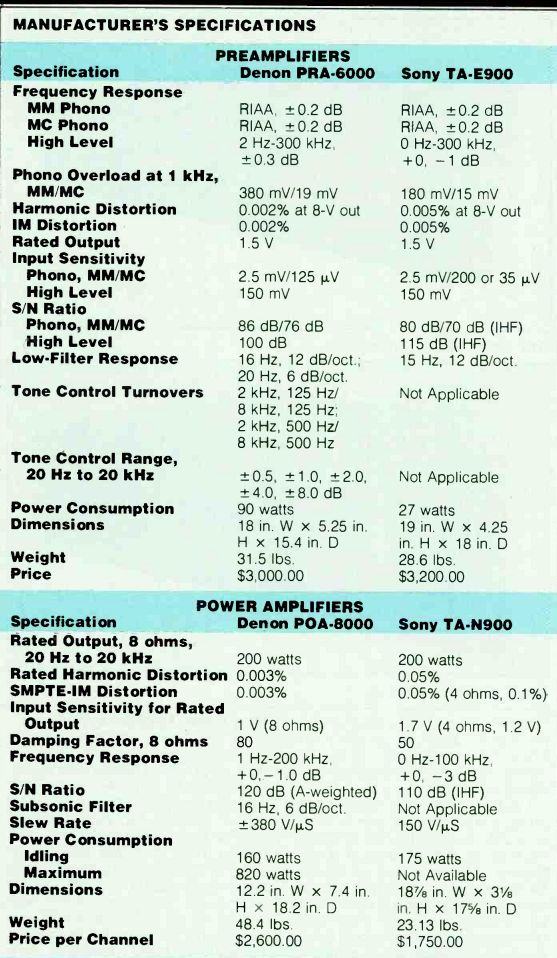
-------- MANUFACTURER'S SPECIFICATIONS
Sony Power Amplifier Layout
The only control on the rack-mount-sized front panel of the Sony Esprit TA-N900 amplifier is a power on/off switch, augmented by a power-on indicator light. The rear panel is equipped with a ground terminal, two input terminals (one of which is for direct d.c. connection, while the other includes an isolating input coupling capacitor), a pair of loudspeaker terminals, and a loudspeaker impedance switch with settings for 2-, 4-, or 8/16-ohm speaker systems. A built-in cooling fan exhausts internally generated heat via a ventilation grid occupying about half the width of the TA-N900's rear panel.
Preamplifier Circuit Highlights
The Denon PRA-6000 preamplifier employs non-negative feedback circuitry. Balanced circuitry with slew rates approaching 500 V/uS is used in all amplification stages. The equalizer/ preamplifier section uses an RC load-impedance circuit of the current-amplification type, with no negative feed back. The MC pre-preamp has a non-negative feedback circuit with balanced power supplies. Switching from MM to MC (in the Phono 1 circuitry) is accomplished electronically.
The pre-preamplifier of the Sony TA-E900 employs a common-base, complementary push-pull amplifier in cascode connection. The equalizer, input buffer, and flat amplifiers which follow are made up of a bootstrapped cascode differential amplifier, a cascode differential amplifier, a cascode mirror-load circuit, and an output stage made up of a Darlington emitter-follower, single-ended push-pull circuit. The equalizer amplifier is of the non-feedback type. Two regulated power supplies are used for each channel.
Amplifier Circuit Highlights
The Denon POA-8000 is a Class-A monaural amp which does not use conventional negative feedback for distortion reduction. Instead of overall loop feedback, a distortion elimination circuit is built into each stage of the amplifier. The power stage is a three-level Darlington design which employs six series-connected high-speed transistors, each with a dissipation capacity of 150 watts. The p.c. board of the power transistor section is made of a glass-epoxy resin coated with oxygen-free copper, 150-microns thick. A toroidal power transformer is used in the highly stable power supply. A block diagram of the POA-8000's circuitry is reproduced in Fig. 1.
The Sony TA-N900 amplifier also operates in pure Class A. Pre-power stages consist of a bootstrapped, double-cascode, FET differential-input stage with current-mirror output; a bootstrapped cascode inverting amplifier, and an emitter-follower, single-ended push-pull driver stage. Double-diffused power MOS-FETs are used in the power output stage. A distortion reduction circuit operates by control ling gate bias in order to improve power stage linearity. A high-efficiency cooling system accounts for the relatively compact size of the TA-N900. It consists of a heat pipe, heat-sinks, and a crossflow fan driven by an extremely quiet linear-torque brushless and slotless motor-the same type as that used in Sony turntables and tape decks. The system draws in cooling air from the bottom of the amplifier, exhausting it from the rear via a ventilation grid. The power stage uses no negative feedback loops and is a pure-complementary, single-ended push pull output operated in Class A. A "pulse-locked" power supply is used in the amplifier. Partial block diagrams of the TA-N900 circuitry are reproduced in Fig. 2.
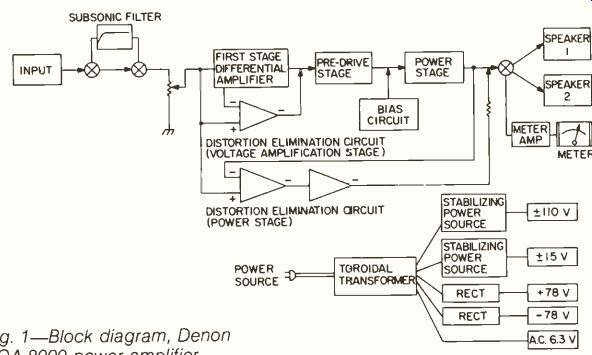
Fig. 1--Block diagram, Denon POA-8000 power amplifier.
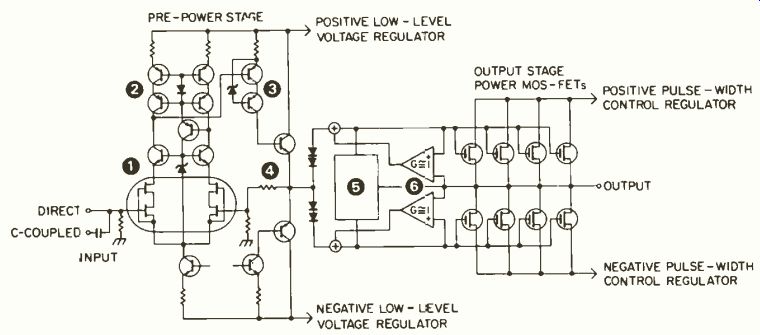
Fig.
2A--Partial schematic of Sony Esprit TA-N900 amplification stages. Legend:
(1) Bootstrapped double cascode FET differential amp, (2) cascode current-mirror
load, (3) bootstrapped cascode inverter amp, (4) emitter-follower SEPP output,
(5) peak current (PC) limiter, and (6) distortion-reduction circuit.
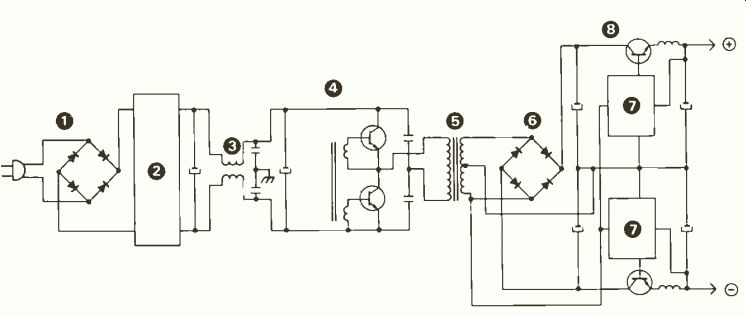
Fig. 2B--Partial schematic of Sony Esprit TA-N900 pulse-width power supply
Legend: (1) Primary rectifier, (2) current surge suppression circuit, (3)
line filter, (4) 20-kHz power oscillator, (5) converter transformer, (6)
secondary rectifier, (7) pulse-width control circuit, and (8) pulse-width
control voltage regulator.
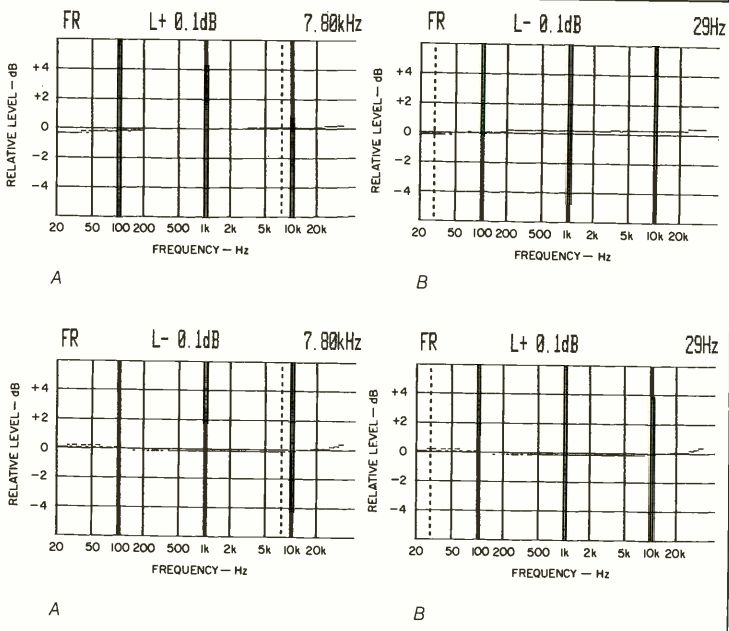
Fig. 3--RIAA response curves, Denon PRA-6000 preamplifier with cursor set
to 7.80 kHz (A) and 29 Hz (B). Note expanded vertical scale of 2 dB/division.
Fig. 4--RIAA response curves, Sony Esprit TA-E900 preamplifier with cursor set to 7,80 kHz (A) and 29 Hz (B). Vertical scale has again been expanded to 2 dB/division.
Preamplifier Measurements
Phono (MM) input sensitivity for both preamplifiers was identical, at 0.9 mV, referred to 0.5-V output. Measured from a 50-ohm source impedance, it appeared as though the Denon unit's pre-preamplifier offered more gain from input to main preamp output than the Sony unit; sensitivity measured 50 1.0/ for the Denon and 312 uV for the Sony model. With an ultra-low terminating impedance of 4 ohms, however, sensitivity of the Sony's MC input came very close to that of the Denon unit, measuring 55 1.0/ for the same referenced output. As for RIM equalization, both preamplifiers offered accuracies within 0.1 dB of the prescribed playback curves throughout the audio band, as shown in Figs. 3 and 4. Note that the vertical sensitivity of these displays has been expanded to 2 dB per division, rather than the usual 10 dB per division. The Sony response curve (Fig. 4) exhibits a slight tendency to rise in the super-audible region (around 30 to 40 kHz), but even this slight rise did not deviate from flat response by more than 0.25 dB.
Phono overload for the MM inputs (using a 1-kHz test signal) measured a very high 400 mV for the Denon and a more than adequate 225 mV in the case of the Sony preamplifier. Switching to the MC input mode, overload occurred at an input level of 23 mV for the Denon unit, while the Sony preamplifier was only able to handle 5.5 mV before overload was noted. I suspect that some of the higher output moving-coil cartridges now available might cause a problem when operated into this MC input, although when using a favorite MC cartridge (custom-produced by Bang & Olufsen) I encountered no difficulties with either preamp during the listening tests.
The Sony preamp does not incorporate tone control circuitry, as mentioned earlier. Figure 5 shows the boost and cut characteristics of the tone controls provided in the Denon unit. Note that it is possible to select either of two turnover points in the bass region for use with either of the two turnover settings available for the treble control.
Turning to distortion measurements, THD was so low on both preamps that all I could read was the residual distortion of the signal generators and test equipment (around 0.002% at mid-frequencies, rising to around 0.003% at the frequency extremes). The SMPTE IM distortion measured around 0.0015% for units, a coincidence which leads me to believe that here, too, I was reading residual instrument IM and not any distortion products produced by the units themselves. It al most goes without saying that the 80 dB dynamic range of the spectrum analyzer prevented my seeing any IHF IM distortion products at levels below clipping for either preamp. The dynamic range of 80 dB corresponds to a distortion level of 0.01%, so the best I can say is that any and all forms of IM distortion which might have been produced from twin-tone test signals were well below this figure.
The frequency response of the Sony unit's high-level section surpassed that of the Denon. It extended out to 1.25 MHz (yes, that's MHz) for a-1.0 dB roll-off and still further out to 1.5 MHz for the cutoff point of-3 dB. The Denon unit was down 1.0 dB at 160 kHz and-3 dB at 200 kHz. Obviously, the bandwidth of both units is more than any of us needs.
Coincidentally, signal-to-noise ratio for the MM phono inputs of both units was precisely the same: 89 dB below 0.5-V output, referred to 5-mV input. That's about as high an S/N figure as I have ever measured for any phono preamp input, using the new IHF/EIA input and output reference values. As for S/N of the MC input, the Denon unit exhibited an incredibly high 85 dB, while the Sony unit managed a respectable 74 dB. For the high-level in puts, the Sony unit did a bit better than the Denon, measuring 94 dB (referenced to 0.5-V output and input) against 90 dB for the Denon preamp. All signal-to-noise measurements are A-weighted.
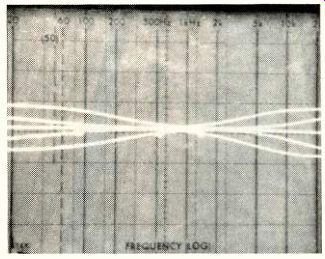
Fig. 5--Tone control characteristics, Denon PRA-6000 preamplifier.
Power Amplifier Measurements
Sony's claims regarding harmonic and IM distortion for their Class-A TA N900 are considerably more conservative than those made by Denon for their POA-8000. Both amplifiers did considerably better than the claimed figures at rated output levels and be- low. At mid-frequencies, the Denon unit reached clipping levels at a power output of 231 watts (8-ohm load), while the Sony unit began to clip when power output reached 262 watts (8 ohm load). Neither of these amplifiers lists 4-ohm power ratings, but I measured them at that impedance anyway, after first throwing the Sony's impedance switch to the appropriate position. The Sony amp delivered 240 watts under these conditions, for a THD level of 0.1%; the Denon unit produced 220 watts at the lower impedance before THD rose above the nominal 0.003% rating. Real clipping at 4 ohms occurred at a considerably higher power output level-more like 250 watts.
The Denon unit exhibited marginally higher dynamic headroom than the Sony amp, 1.4 against 1.02 dB. Damping factors were very close to published figures, 75 for the Denon amplifier and 52 for the Sony. The CCIF-IM distortion figures were 0.0033% for the Denon amplifier and 0.0167% for the Sony. I was able to detect a bit of IHF IM distortion for the Sony amp using spectrum analysis and mathematical summation of observed components of distortion in the audio band. The results of my calculations showed that the Sony was producing all of 0.03% IHF IM at rated output. Frequency response for both units extended well out beyond 100 kHz for the-1 dB roll-off point. Input sensitivity for rated output was 1.1 V for the Denon unit and 1.65 V for the Sony TA-N900. Input sensitivity decreased to 1.2 V for the Sony amp when the load impedance (and the impedance switch setting) was changed to 4 ohms. Both amplifiers retained stability when 2-µF nonpolarized capacitors were shunted across the load resistors used in the bench tests.
Signal-to-noise ratios for the amplifiers measured 94 dB for the Denon unit and 95 dB for the Sony, both referred to 1-watt output. Since the Sony amplifier is not equipped with an input-level control, I had to interpolate to obtain its S/N figure: There was no way to establish standard input level (0.5 V) while at the same time adjusting output for the standard 1-watt level at which these measurements are supposed to be made.
Listening Tests--The Moment of Truth
With amplifiers and preamplifiers such as these, what possible program sources could I use to identify subtle differences, if any, between the two systems? Why, Compact Discs, of course! Happily, I was in the process of testing my very first DAD player when I first auditioned the Sony Esprit system, and by the time I measured and listened to the Denon components, I already owned my very own digital disc player. So, although the listening tests were not blind A-B, at least the program material used in both cases was identical-and superb. So, too, was the quality of sound delivered by both systems. (I told you at the outset not to expect a clear winner, so don't look so disappointed!) Were there any other physical differences between these two superb systems that are worth noting? Yes, there were. The Sony amplifiers are more compact and much lighter in weight, but that is accomplished in part by the incorporation of forced air cooling. And, as with any forced air cooling system, if you listen carefully (especially when there is no surface noise or tape hiss to mask it) you can hear the fan when it operates. Unlike some public-address amplifiers which feature fans that only turn on when things get too hot, the cooling system in the Sony TA-N900 operates continuously, however quietly. If the amps are at some distance from you, no problem. If you're right on top of them, you will hear the fan motor during ultra-quiet passages of music. The solution, of course, is to get the amps out of the listening room altogether.
That's not necessary with the Denon system, where larger heat-sinks and a generally larger and heavier construction obviate the need for a forced air cooling system. Indeed, this is a good thing because the Denon units, with their attractive solid-aluminum side panels, are worth showing off. All three components are truly beautiful looking as well as beautiful sounding-and that's not easy to achieve with a three-piece electronic preamplification and amplification system.
If you were considering these two systems for possible purchase, one of the determining factors might be your attitude regarding the need for tone controls. If you feel they are superfluous or even detrimental, as so many audio purists seem to believe, then you would obviously lean towards the Sony system. If you feel that tone controls, if executed with care and used in moderation, can prove to be an asset--especially when program material itself or room acoustics need some measure of tonal compensation--then you will want to look carefully at the Denon trio.
As for my listening tests, using the finest program material on Compact Discs that I was able to obtain, I could detect no difference in quality between the Sony and Denon systems--again, bearing in mind that I was unable to conduct instantaneous A-B comparisons. More important, I consider each of these systems to be a superb example of the audio art and science. If nothing else, the tests proved to me that a company that makes most of its sales in mid-priced components, such as Sony, can turn out products to de light the most esoteric of audiophiles. Similarly, a company like Denon, whose high-end electronic products are perhaps not as well known in this country as are its turntables (which are acclaimed even by the high-end audio fraternity here) can turn out amplifiers and preamplifiers whose performance is second to none.
(Source: Audio magazine, June 1983)
Also see: